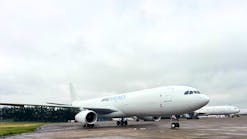While LEED remains to be the source for rating sustainable initiatives at airports, industry members question whether or not an airport-specific association would be a better business tactic. The current evaluation systems for sustainable practices — if the practices are even recognized — vary on a site-to-site basis even though initiatives that were once considered environmentally friendly, but financially risky, are now a point of interest in terms of saving on the bottom line. As a result of fast-paced information sharing, airport managers no longer have to speculate and wait for the next conference to share statistical data. Now they have the ability to find quick answers to big decisions. It’s no longer a matter of when to go green or why? The question now is, how best to go green?
According to sources within the industry, the idea of airports “going green” is still in its early stages; however, as the industry continues on a path that calls for greater sustainability, the age of information is making it easier to share successful business practices.
“Airports in general are in their infancy,” says Jim Crites, executive vice president of operations for Dallas/Fort Worth International Airport. “But airports are rapidly acquiring a keen understanding and appreciation for what we’re now starting to understand to be sustainability.”
According to Crites, airports are on a steep learning curve as a result of information sharing. By utilizing the Web and other mechanisms, airports are becoming more action-oriented now that it is easier to disseminate and take advantage of lessons learned at other locations.
Many airports’ current practices would be considered sustainable, says Cheryl Koshuta, chief environmental officer for the Port of Portland. The pitfall is coming as a result of the airports’ lack of recognition. Koshuta cites energy conservation measures — which many airports have been looking at implementing for years — as a cornerstone of a sustainable program that may not be recognized. According to Koshuta, sustainability is something that most airports are looking at or aware of, but most are trying to understand what it means to their business.
“The industry is in flux right now,” says Koshuta. “Because the [sustainability] concept is different for each airport, the program really needs to reflect the environmental and social conditions of that particular airport. There is no cookbook or checklist that would enable you to compare one [airport] against another, but it is definitely a trend that is beginning to gain momentum.
LEED — the right direction?
As of today, the closest thing to that airport checklist is the Leadership in Energy and Environmental Design (LEED) green building rating system from the U.S. Green Building Council (USGBC). A facility can earn various levels of LEED certification by attaining a number of points based on the sustainability and performance of a building during its lifecycle.
According to Koshuta, the whole concept of the LEED standard is just one small segment, albeit an important one, in terms of what sustainability needs to be at airports. “The current LEED standard does not work well with airports,” says Koshuta. “There is definitely a need to look at a modification or specificity for airports.”
Koshuta states that one example of LEED criteria falling short concerns the points a facility can earn for density. “The [LEED] idea is to not encourage sprawl,” says Koshuta. “[Criterion] like that doesn’t really reflect the reality of what we’re trying to do at an airport.”
“I don’t think that airports were individually evaluated by the US Green Building Council when they came up with their system,” says Greta Hawvermale, assistant project director for the midfield terminal project at Indianapolis International Airport. “I think it is more geared to office buildings, so it has been challenging from an airport perspective to attain all the points that you really want.”
Hawvermale says that the Indianapolis Airport Authority board wanted the new midfield terminal project to be as sustainable as possible. The board wanted accountability; it wanted a way to demonstrate that the project had accomplished sustainability and, as a result, chose to follow the LEED program.
While adhering to the LEED standard, the midfield terminal project had concerns about standing water and attracting wildlife. “Under the USGBC, there are points for doing things with drainage that could lead to attracting wildlife; there have been challenges from that mindset,” comments Hawvermale. “What you might have in a normal office setting in terms of green spaces and various kinds of water features are not things that we want to encourage at an airport.
“I think it would be useful if in the airport industry, there was more dialogue and experience-sharing in terms of what is going on. The more minds we have thinking about a situation, there’s more potential for innovation and there is a synergy among them.”
Disseminating Best Practices
DFW’s Crites, who is also the aviation group chair for the Transportation Research Board under the National Academies of Sciences, states that airports are benefiting from LEED in regards to how facilities are designed and constructed. TRB’s aviation group is taking it a step further by setting up the Project Panel on the Synthesis of Information Related to Airport Problems, an aviation sustainability subcommittee under the Airport Cooperative Research Program chaired by Burr Stewart, strategic planning manager for the Port of Seattle.
According to Crites, the aviation group is using this mechanism not only as a forum to identify best practices in any industry in regards to sustainable development, but also to distribute information to all airports and any interested parties.
“Where we go with sustainability is a step beyond LEED in that we’re very interested in the day-to-day operations of facilities,” says Crites. “So while LEED takes on [constructing] a new facility, we believe there are many benefits from how you operate that facility and how [the airport] operates in general.”
The step beyond LEED is what is called the Asset Development Sustainability Initiative (ADSI), which takes into account where an airport is getting its source materials. ADSI encourages the use of local suppliers so that the total energy consumed to construct a building is minimized. ADSI also encourages airports to take advantage of efficient lighting, heating, and cooling, and use wear-resistant materials, among other things.
Airports Council International – North America (ACI-NA) has also put together a sustainability initiative that looks at the different practices that are happening at airports across the board.
Carol Lurie, a senior planner with the consulting firm Vanasse Hangen and Brustlin, Inc., is a member of the ACI-NA subcommittee on sustainability. She reports that ACI-NA is working to come up with something that is LEED-like, but also attempting to figure out what makes the most sense.
“What we’re trying to do is figure out what best suits the industry,” says Lurie. “The problem with LEED is that it really looks at it from a building-to-building facility approach, and what we want to do is a citywide approach, or an airport-wide approach.
“How can you understand an air quality program airport-wide if you’re only focusing on it from building-to-building?”
At PDX, an emphasis
on waste disposal
PDX is currently using a recycling program that not only recycles all the typical materials (paper, plastic, glass, etc,) but food waste as well. The airport is recycling both pre- and post-consumer food waste that is shipped off to a composting facility. Not only is the recycling happening in the kitchen, but food waste that is collected from tables cleared in the dining areas is recycled as well. PDX, however, is not capturing 100 percent of the food waste — some of the food is cleared by the consumer in food court areas.
“It is a huge diversion of waste from the landfill,” says Koshuta, who has been working closely with the concessionaires at PDX. “We did a lot of outreach [to vendors] when we started the program. We do a lot of training for their kitchen staff, because that’s really where the rubber hits the road.” The kitchen workers have three separate trash bins: recyclable, compostable — which uses different, compostable bags — and regular trash.
While it may be an environmentally friendly practice, it has yet to translate to the bottom line. “We don’t think we’re saving any money yet in terms of overall cost,” says Phil Ralston, general manager of aviation, environmental and safety with the Port of Portland. “We invest in doing pilot projects that are costing us money that we feel are worth doing. The whole intent is to drive up diverted waste from landfills and the amount of landfill waste per passenger.”
Right now, the food waste program is actually costing PDX about five dollars more per ton. They currently pay $98 per ton for the costs associated with the collection and shipping of food waste. PDX is paying $93 per ton for garbage transportation and disposal.
“With this program, there is still a gap between making us money and costing us money, but we want to be the leaders and we want to make sure this thing gets off the ground,” says Ralston. “By pulling more partners into this program of collecting food waste, the volume and the benefits of the scale will bring the cost down to what garbage will be and hopefully, at some point, cheaper.”
PDX is looking to generate greater outside interest within the Portland community to increase volumes of compost material and hopefully encourage a composting facility to relocate closer to the airport, thus eliminating additional shipping costs and harmful emissions. PDX is currently shipping the compost nearly 170 miles to Cedar Grove, WA.
The airport also recycles grease collected from fryers to be used to make biodiesel, and is looking into a deplaned waste recycling program.
Reusing Materials at Ind
As IND went through the design for its midfield terminal project, the staff made sure that it had incorporated the various aspects of the LEED checkpoint system into the design. The project emphasized the reuse and recycling of old taxiways and runways, which were reused as site fill on the project. According to Hawvermale with IND, they are looking to recycle wood and metals as well to minimize the amount of waste to landfills.
In the construction of the new terminal, the airport is using a type of glass that shades the impact from the sun to lower air conditioning costs and reduce energy consumption. They are also using environmentally friendly paints and sealants that don’t release compounds that create indoor air quality concerns.
According to Hawvermale, one of the particularly innovative ideas that was incorporated was the relocation of a stream. During the move, a number of large trees had to be cut down. The roots (also called root balls) were excavated and used to stabilize the banks of the relocated stream. “Even with something as simple as cutting down a tree, we were able to recycle those root systems into a very important part of our stream relocation project,” says Hawvermale.
There are also intangible benefits to some sustainable initiatives, says Hawvermale. She cites using as much natural light as possible in the terminal to improve employee and passenger morale. Also, by reducing the amount of chemicals produced from paints and sealants, IND can provide better indoor air quality that could translate into potentially healthier employees and less illness, thereby increasing productivity.
Dfw’s Energy-SavingIinitiatives
“Airports are like mini-cities; they make great laboratories to look at the cause and effect of new initiatives,” says DFW’s Crites. “We are validating the benefits of a lot of these new technologies that may be hard to establish elsewhere.”
As a part of the new technologies that DFW has put into action, it has converted its central utilities plant and now produces all the thermal energy for every building at the airport. DFW recently completed a capital development plan in which they removed their 22,000-ton capacity chillers and replaced them with six 33,000-ton industrial chillers. DFW now can produce 405,000 pounds of boiler capacity per hour to heat and cool six million square feet of building space.
By replacing the equipment, Crites says that DFW reduced its harmful emissions by 95 percent and reduced energy consumption to produce that heating and cooling by some 25 percent.
DFW has also installed a six million-gallon storage facility filled with glycol for temperature control. The glycol can generate the equivalent of 12,000 tons of coolant, or 51 million BTUs worth of heating.
Depending on the season and the airport’s need, DFW heats or cools the glycol at night, taking advantage of off-peak pricing from energy companies. During the peak periods of the day, Crites says that DFW can turn off the chillers and feed off of the super-cooled glycol by pumping it around the building. By doing this, the airport has reduced its peak period demand for energy by 85 percent.
Crites says that DFW has also found success in retro-commissioning buildings. In partnering with the energy systems lab of Texas A&M University — the consulting arm to the Texas Commission on Environmental Quality — the airport has found ways to make existing buildings more efficient. The lab’s findings revealed that due to poor thermostat placement, air handlers were pumping into the wrong areas. Once the building was retro-commissioned, DFW saw a 25-percent reduction in that building’s energy requirement.
DFW is now receiving both environmental and cost benefits with the installation of the largest volume compressed natural gas (CNG) station in the U.S., which feeds the largest fleet of CNG vehicles in the nation. According to Crites, the station — which pumps 150,000-170,000 gallons of CNG a month — is not considered a source of revenue, but rather as a cost offset. Last year, the DFW station pumped 1.3 million gallons of CNG fuel, saving over $2 million had those same vehicles been fueled by gas.
“There’s been a reluctance to take on [new] things just because of the lack of hard data,” says Crites. “Well now that we have measurable results, as we make this information known, the guys who are most excited about sustainable development lately have been the chief financial officers, because they’re starting to see improvement on the bottom lines.”
James Harger, senior vice president, marketing and sales with Clean Energy, a CNG provider, says the biggest reduction in emissions comes with changing a diesel powered vehicle to CNG. “When a diesel bus [averaging 15,000 gallons per year] is taken off the road and a natural gas bus is put in its place, it’s the equivalent of taking 325 automobiles off the road in terms of emission reduction,” Harger says. He states that the conversion will also cause a 20 percent reduction in greenhouse gases.





